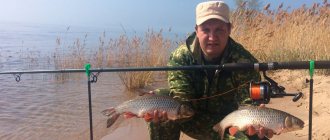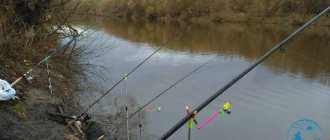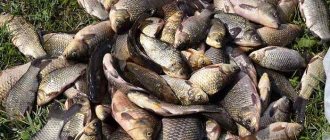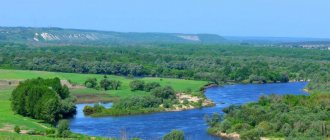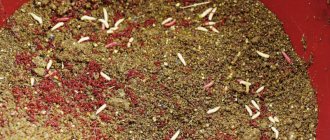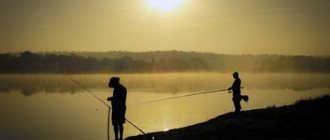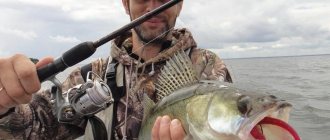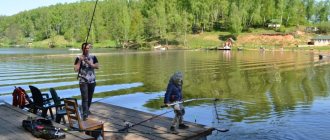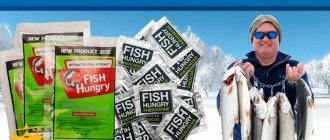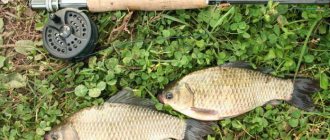The feeding habits of fish in cold water and typical fishing spots in different types of water bodies depend on the period of autumn.
- Fishing in autumn ponds and lakes
- Blind tackle. Heavy rig on thin line
- Fishing in still water
- Earth and animal components
Features of autumn fishing
Autumn can be divided into three periods, according to weather conditions and water temperature:
- Until the water temperature drops below 12 degrees, the summer behavior of peaceful fish remains;
- Transitional, but the longest period of cooling of water to a temperature of 4 - 6 degrees;
- The final pre-winter period.
True autumn fishing occurs in the second period. Fishing becomes accurate, technically complex, one might say, subtle, but rewarding.
The characteristic features of autumn include, first of all, the fact that as the water gets colder, the development of aquatic plants greatly slows down. Annual plants throw out seeds and die, perennial plants shed some of their foliage, and floating ones sink to the bottom. The water quickly becomes clear due to the death of microalgae.
With the cessation of plant growth, insects, their larvae, worms and mollusks change their behavior. The larvae leave the coastal zone and descend deeper, for example, caddisfly larvae go to a depth of 2-4 meters. Mollusks also move to deeper places.
In such conditions, when all living things are preparing for winter, the fish have no choice but to do the same and adapt to the changed conditions. And the fish is also actively being prepared, despite the fact that it has already built up its fat reserves over the summer.
Fish feeding activity in autumn
However, the fish is prepared, one might say, measuredly and slowly, that is, it does not rush at everything that comes under its nose. Despite the food supply becoming scarcer every day, peaceful fish are becoming more and more cautious and sedentary. Cautious due to clearing of water and relative satiety, and sedentary due to a decrease in temperature. Of course, this applies to such traditional fishermen’s hunting objects as roach, bream, bleak, dace, chub or ide, not to mention crucian carp and crucian carp.
But it is worth emphasizing that under certain weather conditions, even in October, periodic outbreaks of feeding activity of peaceful fish are observed. If you guess such a period, choose the right place and prepare well for fishing, then the fishing productivity will be very high. Now, although the process of seasonal cooling of water has just begun, aquatic inhabitants already have a good sense of how it will all end and are changing their habits and behavior.
Fishing place. Autumn ponds
Before going to a particular body of water, it is worth deciding whether it will be a river, a lake or a reservoir. Technically, the hardest time to catch a big fish is on a shallow lake in clear water. On a reservoir or large river, you need to know exactly the places where the hole or channel comes close to the shore, as well as places with a deep bank edge, immediately beyond which deep watering begins. Or switch to fishing from a boat to fishing.
It is relatively easy to fish on small rivers, but the catches will be appropriate, since migratory fish have already begun to descend into the reservoirs, and small local fish remain. Among the local fish, of course, there are worthy specimens, but for each of them you have to organize a separate hunt at shallow depths in clear water. The tributaries of large rivers are good. It combines sufficient depths, not too strong a current, the ability to “read” the bottom topography visually based on the shore topography, explore the topography and find a fish site.
Now it’s worth fishing where you had a good rest in the summer, but you just need to approach the choice of fishing location and equipment differently.
Fishing in autumn ponds and lakes
As I already mentioned, it has become most difficult to fish in shallow bodies of water and in places where the depth near the shore does not exceed about one and a half meters. This applies to lakes, ponds, quarries and reservoirs. If in hot weather in the shallows at dawn it was always possible to find feeding fish, now here they cannot find summer food. The exceptions are coastal thickets of reeds and reeds, and uruti thickets. Small fish are still feeding here, but if you aim for perch, you can find them just off the shore. The perch has already begun a school hunt for the fry.
In shallow bodies of water, the most common places for fishing are now near holes, underwater ditches, and generally near the deepest places in the body of water. This does not mean that you need to look for fish in a hole. It is located near, on the edge or on the adjacent irrigation. It is characteristic that the fish may not stand at the bottom, but at half-water, but above a relatively deep place.
The easiest way is to decide on a fishing location in a quarry or deep lake. Here the bottom topography is sharp, with changes over long distances, and it is enough to either move a couple of meters to the side, or take a rod a meter longer. As in the summer, the fish usually stands behind the first shore edge, but it does not come out to the edge itself every day and the periods of exit are reduced in time. The weather and the reduction of daylight hours are becoming increasingly influential. The bite becomes short-term and episodic.
In flowing ponds formed by dams, the fish gradually move down to the area before the dam and rarely leave it, but sometimes they leave. After heavy rain, especially if it is not cold, the fish often rises to the upper reaches, goes to shallow places, to the edge of the turbidity, but these exits are quite short-lived.
Autumn fishing in small rivers
On small rivers, I repeat, the bulk of the fish slide into deep places with spills and dams, and local fish are concentrated in holes, pools and barrels. It should be noted that it is in small rivers that the onset of cooling affects the behavior of fish least noticeably. This is also explained by the fact that here the usual summer food supply undergoes the least changes.
Small rivers are almost always fed by cold water from springs, and the main food for fish are caddis flies and worms, which are sufficient not only in summer and autumn, but also in winter. What makes fishing on a small river more difficult is the same clearing of the water. It sometimes becomes impossible to camouflage when fishing in shallow places. You creep up to the shore and see how roaches and chubs move from shallow places into the depths, onto the stream or into the nearest hole. It is not possible to lure them out of there, so the summer gear has to be changed.
If in the summer you can sometimes fish well on a small river in a quiet bay or behind a cape and a bend in the riverbed, and fish in almost still water, now you have to fish in the current. The fish stands near the stream of current. Here it is both safer and more likely to intercept floating food.
Autumn fishing in large rivers
On a more or less large river, there is also no point in stopping in shallow areas without a current. It is worth looking for a stream of current passing under the shore. The stream should not be too strong, since the fish saves energy, and the food settles along the boundaries of the stream. The best places are located close to the shore, with a sharp drop into the depths, but with a smooth and weak current. On large rivers, the most promising holes are behind capes and underwater spits, as well as underwater ditches running along the shore.
In general, when fishing on any type of reservoir, deep places located behind the coastal shallows are now promising. Among the relatively shallow places, underwater spits with a depth of at least a meter and submerged islands should be noted. In warm weather, fish, including large ones, will come here for a long time.
The difficulty is that these exits are short-term, difficult to predict and technically difficult to catch. You have to use the longest fly rods, long casts, and often a boat.
Rod
To catch autumn roach, it is enough to get a 5-7 meter rod. Most often I use the 7-meter Team Salmo TOURNAMENT POLE, and the 6-meter Team Salmo POLE.
Both rods are very light and have a fast action. With a rod in which only the tip bends when casting, it is very easy to control equipment whose weight ranges from 2-4 grams.
If the main line is made half a meter shorter than the rod, then even with a strong side wind the presentation of the bait turns out to be almost like that of a plug. The bait on the hook can be held much slower than the current, or even stopped at the point you need. With a softer rod, you are unlikely to succeed in such a “trick”.
I use a short rod in cases where there is not much pressure from anglers on the shore, and the fish can be pulled to the shore with bait. A long rod comes in handy in cases where the shore is noisy, and in order to see the bite, you need to cast the tackle a little further than your neighbors. It is advisable that the rod for catching roach be equipped with a flexible monolithic whip of the “whalebone” type. Having a flexible tip allows me to work with the thinnest leaders, which in cold water significantly increases the chances of success.
Autumn fish and float tackle
In any case, you need to be prepared for the fact that the fishing scheme that has become familiar over the summer ends. The time has come to catch well-fed and cautious fish at depth in clear water. Depth will require the use of longer-range and heavier equipment.
Thin equipment, the right bait, and an autumn set of baits will help deceive cautious fish. The main thing now is to restructure yourself internally and realize that a completely different fishing has begun. Neat and technically more complex.
During this period of open water, I make an effort on myself, put aside the summer equipment and redo the gear. A new fishing season is coming - autumn deep fishing, during which you will probably need the entire available arsenal of gear.
Blind tackle. Heavy rig on thin line
Depth, especially in the current, requires heavier equipment, which is less sensitive to bites. However, there is no choice. You need to choose equipment as heavy as required by the fishing conditions, while sacrificing sensitivity, otherwise you will not catch anything at all with uncontrolled and uncontrolled equipment.
This is where the advantage of thin tooling becomes clearer than ever. Thin - this means constructed on the thinnest fishing line using the highest quality sinkers and hooks. Thin fishing line often makes it possible to reduce the optimal weight of equipment for given conditions by one and a half times.
This happens automatically by reducing the resistance of the fishing line in the water and by reducing the windage under the influence of the current. High-quality sinkers, or rather stationary pellets, are needed in order not to twist the thin line.
On heavy equipment, this requirement for the quality of pellets becomes especially relevant. Good pellets are clamped onto the line in a completely symmetrical manner. All components and additional elements on the equipment must be made as carefully as possible.
Fishing ban on the Don
— from May 1 to June 1, a ban is introduced on recreational and sport fishing in the Tsimlyansk Reservoir: from the dam to the railway bridge at x. Spoons; - from April 25 to June 1 - in the Don River: from the railway bridge at x. Spoons in the Tsimlyansk Reservoir to the administrative border of the village of Trekhostrovskaya, with the exception of catching aquatic biological resources with one float or bottom fishing rod with one hook per fisherman, spinning from the shore without the use of all types of watercraft; — catching crayfish is also prohibited from January 1 to September 15.
In addition, during the spawning period the use of small vessels on the Don is prohibited . Read more about the spawning ban on the Don at the link:
- Spawning ban in the Rostov region 2013 >>>
The main document regulating fishing on the Don, as we have already mentioned, is the “Fishing Rules for the Azov-Black Sea Fishery Basin”, approved by the Federal Fishery Agency on September 8, 2008. The rules are mandatory for all fishermen and establish, in particular, the tools and methods prohibited fishing during fishing on the Don, restrictions on the timing and places of fishing on the Don, the minimum size of caught aquatic biological resources for which this size is established.
Fishing techniques in bad weather
The rainy season is beginning, which will make fishing inconvenient and affect the behavior of the fish. Up to a certain value, an increase in turbidity and water level does not worsen the bite, but even improves it, but when the water becomes like coffee grounds, the bite may stop altogether.
When choosing a reservoir, you need to focus on its size, depth near the shore, flow speed and nature of the soil, as well as protection from strong winds. On small rivers flowing in high banks, the water becomes cloudy most quickly. A similar situation is very likely on a small pond with gently sloping silted and clayey banks. Gusts of wind during bad weather help spread turbidity throughout a small body of water. The worst thing is that the turbidity in ponds settles very slowly.
On large bodies of water, the closer the shore edge is, the closer the turbidity line is to the shore. Small rivers and streams almost always flow into the reservoir. They can carry the muddiest water right now, so it might be worth staying away from such areas. This is not observed on lakes and ponds.
When choosing a specific fishing location, I focus on such parameters as the distance to the turbidity border, the border of coastal underwater vegetation and depth.
It is very difficult to visually determine the “working” limit of turbidity; more precisely, it is difficult to explain how to do this. Thus, it turns out that in addition to the fact that the fish are already moving to deep places because of food, they are also stimulated to do so by weather conditions.
The fishing technique in conditions where the fish is not chasing the bait becomes more accurate.
The number of effective fishing techniques is narrowing, but heavy equipment, as it has great stability and stability when retrieved, makes it possible to perform them competently. You just need to not be lazy and try.
Fishing in still water
In still water, the bait is usually held in place or moves very slowly by the surface current. Artificial wiring should be as slow as possible. The smaller the bait, the slower it needs to be moved. The following wiring diagram is very effective.
After casting a little to the side from the fishing point, after the equipment has taken its working position, I very slowly drag it onto the bait. In this case, the bite most often looks like a hook, this is a hook, but not at the bottom, but at the mouth of the fish, which takes the bait, but does not want to move.
Fall wiring
Retrieving the fall of the rig can only become effective if the bait falls at a very slow speed at the final stage. To achieve this, the sinkers are moved further from the hook, and the underhang is moved towards them, making a leash up to a meter or more in length. With such a distribution of the load, the last stage of the fall of the bait is poorly controlled.
If bites occur during the fall, but you don’t see them, then you need to distribute the sinkers in a chain into parts of the equipment one and a half meters long and vary the length of the leash. Very often, when falling, a bite occurs, which is visible with a delay of two to three seconds. If you catch a fish, do not rush to change the distribution of sinkers. It is worth changing the distribution only if the bite was not visible, and the bloodworm on the hook was “sucked”.
Drawing of equipment
Retrieving by dragging the bait along the bottom is very, very effective, but at a very low speed. Wiring with dragging is good if the bottom is sandy or clayey, that is, “hard”. During the current, this wiring may now become the most popular. Don’t forget about the technique of anchoring the equipment. The bait, lying motionless on the bottom, is to the taste of both carp and bream.
In the current, more and more often the fish refuses to take a free-floating bait. We have to delay the equipment. It is difficult to do this with a fly rod and is effective only at the final stage of the swim. This delay at the end of the swim only works if the tail of the bait train reaches here, which in most cases is the result of improper feeding. You can make holding easier by reducing the length of the rig by a couple of meters. Fishing becomes less comfortable, but much more effective. Wiring by dragging the bait along the bottom and anchoring the equipment helps.
Anchoring equipment
Anchoring is rarely used, since to prevent the float from being pulled under water, it is necessary to remove part of the load or significantly increase the descent. Such actions reduce the sensitivity of the equipment so much that you can be left without a catch at all.
In general, fishing with a long fly rod is becoming more and more difficult and it makes sense to use it in fairly calm weather conditions, when the fish takes a stationary bait from the bottom and when the bite is quite active during the free passage of the bait.
Transition to plug
If technically it is not possible to carry out the required wiring, then the plug remains. A relatively short “fly” plug is especially convenient in the conditions discussed, about which more in a week.
Unfortunately, most anglers, instead of taking a plug, either change the fishing location to a less fishy, but more convenient one, or blame the failure on the weather.
Fishing at the end of September
When, towards the end of September, trees begin to shed their leaves and, falling, they form an impromptu blanket in some areas of reservoirs, many species of fish like to hide in such places. In this case, anglers only need to approach them carefully in order to subsequently enjoy fishing. As soon as the baited hook is lowered under the carpet of leaves, the bite does not take long to arrive. Species such as chub, roach, bream, ide, rudd and other types of fish like to accumulate in such places
There is an opinion among fishermen that a particularly good period for fishing is, of course, quiet and rainy days in September, when the rain only drips lightly. Considering the peculiarities of autumn fishing, many also advise, if possible, to use a boat or other means to get to deep waters to cast suitable bait.
As a result, it was noted that not all fish are caught during this period; already in the last days of September, neither catfish nor bream come to the bait and it is useless to try to catch them .
Autumn bait and bait
Particular attention should be paid to bait and bait. Bait in the fishing conditions discussed is absolutely necessary. The compositions are still suitable for warm water, but it already makes sense to think about slightly reducing the total amount of bait and enriching it with components of animal origin. If there are no bloodworms or maggots, then chopped worms and egg powder are effective.
It is very important not to spray the prepared mixture over the area, otherwise the bites will become more pronounced, but more rare. The worst thing is that the fish will not bite at a certain point, but randomly, also over an area. The time between bites can increase many times over.
Earth and animal components
Already now I completely or almost completely refuse bait of plant origin and take a handful of maggots, a handful of worms and a handful of bloodworms, preferably large ones, with me when fishing.
I use five liters of soil as bait. I add a little bit of everything to one or two handfuls of earth. Several dozen maggots, bloodworms and worms chopped into small pieces. I mix it and accurately throw it to the fishing point. After about twenty minutes I try to catch, periodically changing the bait (every 10-15 minutes).
This continues until the first bite, for example, on maggot. I continue fishing until the bite subsides, after which I start changing baits again. If the bite resumes, for example, on a worm, then everything goes as usual. But if the bite does not resume, then I prepare a few more balls of bait. And so on throughout the fishing.
Despite the fact that the bait is enriched with animal components, the fish does not refuse pearl barley, bread, and mash. Moreover, it was during this time that I several times found myself in situations where carp and crucian carp stopped taking the worm and pecked exclusively at a mixture of dough with cheese or dough made from extruded corn.
Fishing in September, its features
The article will tell you about the features of autumn fishing in September. What gear to take with you, and what types of fish are actively biting in September. Choice of place and time, choice of bait.
Content:
Autumn time has come. Most avid fishing enthusiasts try to specially plan their next vacation for the autumn season and for this they are ready to travel huge distances to reach their favorite fishing spots.
